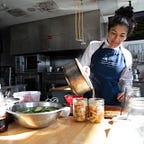Marocchino con Gianduja
A story of hazelnuts, Nutella, labor abuse, and environmental degradation
During my time living in Italy, I obsessed over this coffee drink. The small glass cup showcasing the latte-colored drink, or the darker version with the glass smeared with gianduja and dusted with cacao powder — I was in love.
So, what is a Marocchino?
A Marocchino is a coffee drink equivalent, in a ratio of coffee to milk, to what we know as a latte. In Italy, you won’t find a latte because that’s the word for milk, so if you ask for a latte, you might get a funny look followed by a glass of milk. A marocchino, however, is served in a small glass cup — sometimes served in a glass similar to what in the US we know as a Cortado. Slightly bigger than an espresso cup. The story goes that it was invented in the town of Alessandria, in the Piedmont region, as a less indulgent version of the Bicerin, a famous espresso-based drink from Turin, layered with chocolate and cream. The name marocchino is derived from its color, resemblance to the color of leather made from tanned goatskin or sheepskin, as produced in the area.
The following question after you order a marocchino might be: con gianduja o cioccolato, o le due? I usually chose le due. This means the barista smears gianduja on the inside of the glass, pours in foamy milk, and then brews a single espresso directly on top of the milk, finishing by dusting the clouds with cocoa powder. In most coffee bars the question might be, con Nutella? and to that my answer is always, no grazie!
What is gianduja?
Gianduja is a chocolate paste with about 30 % of hazelnut paste added. The story goes that a chocolatier in Turin decided to emulsify hazelnut paste, cacao, and sugar to stretch the expensive imported cacao he had, thus developing a new product that will dictate the fame of hazelnut confections in Piedmont.
Driving around the region, or simply walking on the farmlands around Bra where I lived, we could see the hazelnut groves filling the spaces in between grapevines, corn, and wheat. Some plots have some life below the trees, but the majority are barren, chemically sprayed death to rid it of any bugs, and stripped bare to make it easy for harvest. Hazelnut, or nocciola, is native to the temperate climates of the northern hemisphere. The variety of hazel trees of Piedmont are known as Tonda Gentile Trilobata, which in the early 1900s saw a significant increase in production due to the development of gianduja.
In Piedmont, hazelnut products fill booths at farmers’ markets and local shops. The list includes whole and chopped hazelnuts, hazelnut paste (move over peanut butter), gianduja with different levels of chocolate from dark to milk, and candies like gianduiotto (shaped like ingots and wrapped in gold or silver-colored foil).
Like any product whose cultural importance is promoted and sold, gianduja moved from an artisanal product made by using the local hazelnuts, to a global industrial product. Enter Nutella.
Nutella and the Ferrero Empire
In the 1950s, the Ferrero family began producing a spreadable chocolate-hazelnut paste by adding more sugar and oil. In 1964 this cream became Nutella. The Ferrero empire is still run locally. The Ferrero factory is located in Alba (a 30-minute train ride from Bra). As soon as you get off the train in Alba the smell of palm oil followed by chocolate and hazelnuts assaults you. The chocolate and toasted nuts are alluring, and just as you are opening your lungs wide for the pleasures and indulgence, the rancid smell of palm oil makes you choke and gag.
Nutella is a worldwide phenomenon. Even during my last trip to Colombia, I saw single-portion packages next to cash registers, encouraging the kids in my family to beg for one, “it’s not bad for me, it’s made with nuts,” they argued.
Nutella is made from more than hazelnuts. In fact, it contains 55 % of sugar, about 23 % of palm oil –and other emulsifiers, leaving only 22 % for hazelnuts, chocolate, and milk powder.
Just as the consumption is global, so is its impact
The idea that Nutella was born out of the abundance of hazelnuts in Piedmont is part of a distant history. Ferrero purchases 1/3 of hazelnut production worldwide to produce its many goods, including a former favorite of mine, Ferrero Rocher, and of course, the world’s beloved Nutella. The company’s power is such that it determines the production standards and price in Italy and abroad.
In Turkey, one of the largest hazelnut-producing countries in the world, the industry is causing severe environmental concerns, in addition to labor abuse of refugees, and child labor.
In Chile, where Ferrero purchased four thousand hectares for unregulated hazelnut production, the use of Paraquat, a desiccant herbicide, banned in the EU, is a concern.
The impact of Nutella goes beyond those caused by hazelnut production. Palm oil production continues to deforest lands in Indonesia, pushing indigenous peoples out of their land, and destroying habitat for the many creatures and plants inhabiting the forest. Inadvertently, we use palm oil in many products, so finding out that our beloved Nutella contains 23 % in each jar, together with unsustainable hazelnut production, makes it a difficult to digest reality.
~ Paula
